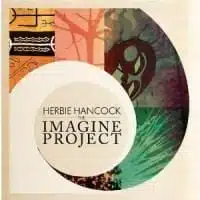
Is it churlish to find extremely good intentions wrong-footed? Is it unpleasant to criticize one of the finest musicians on the planet because his work in “merely” entertaining in a patchwork kind of way? What standing does some critic have to toss tomatoes at the likes of the astonishing and—by all measures I’ve ever heard of—truly generous Herbie Hancock?
Herbie Hancock is a superstar jazz musician—from the grace of “Maiden Voyage” to the hip-swinging funk of “Watermelon Man”, from the slippery groove of “Chameleon” to his cunning Mitchell covers on The Joni Letters. And he’s the rare jazz musician to pen a legit pop hit song, “Rock-it”. If anyone has earned to right a little indulgence, maybe it’s Herbie Hancock.
So, I’m going to start by saying that The Imagine Project is a creative melding of musical styles from all over the planet, and the sentiments in the lyrics of the songs are uplifting. When the individual songs here line up properly, they are exceptional and unusual pop music—creative and refreshing and in the service a greater good.
But as a collection of music by a uniquely brilliant pianist and composer, The Imagine Project is a glitzy but spotty collection. It’s entertaining, but in patches. It’s sonically gorgeous almost always, but it is musically compelling . . . too rarely.
The title track and opening tune, John Lennon’s iconic but done-to-death “Imagine” is a case in point. It is a crazy hybrid tune that uses three guest star vocalists and several styles but generates little sustained magic. The opening suggests some wonder—Hancock alone at the acoustic piano playing some suggestive, impressionistic chords, with the soul voice of Pink entering tartly on the well-known melody. And Hancock knows just what not to play, putting in silences like his great predecessor Bill Evans might have. But soon enough, there is Seal singing as well. We need two guest stars here? Well, they harmonize, so it’s cool. But then there is a new groove, with piano and synthesizer dodging each other in the mix—busier but still cool. And there’s Pink again. But it’s not Pink. It’s India Arie. Which is to say, wha? And moments later there is African chanting over the groove and, wait, a guitar solo by Jeff Beck. Does the track sound good? Sure it does, but in three or four different ways. You could see it as a crazy jambalaya of “Imagine” visions, but what it’s not is a single coherent vision.
This is The Imagine Project in a nutshell.
I really like the version of “Space Captain”, featuring vocalist Susan Tedeschi delivering blues conviction and her husband, slide guitarist Derek Trucks, dueling with Hancock’s piano in the breaks. Originally recorded by Joe Cocker, this tune is amiably straightforward, a gospel-rocker that doesn’t ladle on too much forced eclecticism. But what of Dylan’s “The Times They Are A-Changin'”, where the great folk song is put across with a combination of Hancock impressionism, African guitar prodding, an Irish vocal soloist (Lisa Hannigan) and, what the heck, The Chieftains, laying out some plaintive fiddling. It is a bit of a mess.
And on it goes throughout Imagine. The Juanes feature, “La Tierra”, is slinky Latin pop, with a great mix between measured vocal and piano accents. But “Tomorrow Never Knows” with Dave Matthews is an uncomfortable mix of Beatle-ish psychedelia (backwards guitars, that kind of thing) and world music accents. “Don’t Give Up” is a gentle soul ballad for Pink and John Legend, but “Tamant Tilay/Exodus” is some kind of grooving mutation combining middle-eastern music with Los Lobos and a lot of swirling Fender Rhodes coloration. “The Song Goes On” mashes up Indian music, Wayne Shorter’s soprano saxophone (so far so good . . .) with a backbeat and Chaka Kahn . . . and with slashing post-bop piano runs.
When this kind of wild genre-defying works, the music can be a great success. And no doubt this is Hancock’s intent here. I have nothing but admiration for Matt Glaser and his band Wayfaring Strangers, who manage to fuse bluegrass, klezmer and jazz. But Strangers work toward the same basic combination on each track of a collection, putting together a focused band that finds ten ways to seek its fusion on each album. On Imagine, Hancock is trying to cook up a different bouillabaisse on every track, and the plainer ones are uniformly more palatable. Does that mean he should not have tried so hard? Do the simpler projects demonstrate the overreaching of the more strained ones?
The song I like the most here is “A Change is Gonna Come”, the classic Sam Cooke tune. The guest here is the English singer-songwriter James Morrison, but he is not the star of the track. Rather, the hit here is Hancock’s unabashedly jazzy but clear rhythm section arrangement, which lets his conversational piano shine as a jazz instrument with plenty of room for exploration while still providing a sense of contemporary pulse. This is the longest solo by the leader on the record, and why not? This is the pulsing, creative take that Hancock brought to Joni Mitchell’s great rock-era tunes on his last recording, and its relative absence here is a weakness. Just because Hancock wants to court guest-star popularity here does not mean that he can’t give us his own best work.
The good intentions and spirit of this project—the lyrics that celebrate mankind’s unity and the attempt in the music to sew together the globe’s many styles—ought to count for something. I’ll leave the ultimate balance to you. But on a purely musical basis, The Imagine Project is merely okay, a B- or so, a middling effort from a giant musician.

